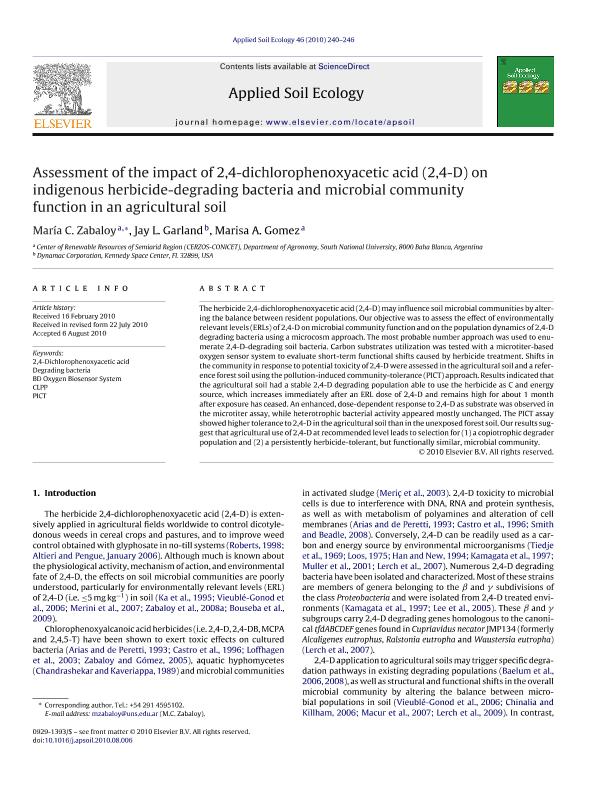Mostrar el registro sencillo del ítem
dc.contributor.author
Zabaloy, Maria Celina

dc.contributor.author
Garland, Jay L.
dc.contributor.author
Gómez, Marisa Anahi

dc.date.available
2017-05-24T21:47:22Z
dc.date.issued
2010-10
dc.identifier.citation
Zabaloy, Maria Celina; Garland, Jay L.; Gómez, Marisa Anahi; Assessment of the impact of 2,4-dichlorophenoxyacetic acid (2,4-D) on indigenous herbicide-degrading bacteria and microbial community function in an agricultural soil; Elsevier Science; Applied Soil Ecology; 46; 2; 10-2010; 240-246
dc.identifier.issn
0929-1393
dc.identifier.uri
http://hdl.handle.net/11336/16949
dc.description.abstract
The herbicide 2,4-dichlorophenoxyacetic acid (2,4-D) may influence soil microbial communities by altering the balance between resident populations. Our objective was to assess the effect of environmentally relevant levels (ERLs) of 2,4-D on microbial community function and on the population dynamics of 2,4-D degrading bacteria using a microcosm approach. The most probable number approach was used to enumerate 2,4-D-degrading soil bacteria. Carbon substrates utilization was tested with a microtiter-based oxygen sensor system to evaluate short-term functional shifts caused by herbicide treatment. Shifts in the community in response to potential toxicity of 2,4-D were assessed in the agricultural soil and a reference forest soil using the pollution-induced community-tolerance (PICT) approach. Results indicated that the agricultural soil had a stable 2,4-D degrading population able to use the herbicide as C and energy source, which increases immediately after an ERL dose of 2,4-D and remains high for about 1 month after exposure has ceased. An enhanced, dose-dependent response to 2,4-D as substrate was observed in the microtiter assay, while heterotrophic bacterial activity appeared mostly unchanged. The PICT assay showed higher tolerance to 2,4-D in the agricultural soil than in the unexposed forest soil. Our results suggest that agricultural use of 2,4-D at recommended level leads to selection for (1) a copiotrophic degrader population and (2) a persistently herbicide-tolerant, but functionally similar, microbial community.
dc.format
application/pdf
dc.language.iso
eng
dc.publisher
Elsevier Science

dc.rights
info:eu-repo/semantics/openAccess
dc.rights.uri
https://creativecommons.org/licenses/by-nc-nd/2.5/ar/
dc.subject
2,4-Dichlorophenoxyacetic Acid Degrading Bacteria
dc.subject
Bd Oxygen Biosensor System
dc.subject
Clpp
dc.subject
Pict
dc.subject.classification
Biología Celular, Microbiología

dc.subject.classification
Ciencias Biológicas

dc.subject.classification
CIENCIAS NATURALES Y EXACTAS

dc.subject.classification
Ciencias del Suelo

dc.subject.classification
Agricultura, Silvicultura y Pesca

dc.subject.classification
CIENCIAS AGRÍCOLAS

dc.title
Assessment of the impact of 2,4-dichlorophenoxyacetic acid (2,4-D) on indigenous herbicide-degrading bacteria and microbial community function in an agricultural soil
dc.type
info:eu-repo/semantics/article
dc.type
info:ar-repo/semantics/artículo
dc.type
info:eu-repo/semantics/publishedVersion
dc.date.updated
2017-05-10T14:21:15Z
dc.journal.volume
46
dc.journal.number
2
dc.journal.pagination
240-246
dc.journal.pais
Países Bajos

dc.journal.ciudad
Amsterdam
dc.description.fil
Fil: Zabaloy, Maria Celina. Consejo Nacional de Investigaciones Científicas y Técnicas. Centro Científico Tecnológico Conicet - Bahía Blanca. Centro de Recursos Naturales Renovables de la Zona Semiarida. Universidad Nacional del Sur. Centro de Recursos Naturales Renovables de la Zona Semiarida; Argentina
dc.description.fil
Fil: Garland, Jay L.. Kennedy Space Center. Dynamac Corporation; Estados Unidos
dc.description.fil
Fil: Gómez, Marisa Anahi. Consejo Nacional de Investigaciones Científicas y Técnicas. Centro Científico Tecnológico Conicet - Bahía Blanca. Centro de Recursos Naturales Renovables de la Zona Semiarida. Universidad Nacional del Sur. Centro de Recursos Naturales Renovables de la Zona Semiarida; Argentina
dc.journal.title
Applied Soil Ecology

dc.relation.alternativeid
info:eu-repo/semantics/altIdentifier/url/http://www.sciencedirect.com/science/article/pii/S0929139310001320
dc.relation.alternativeid
info:eu-repo/semantics/altIdentifier/doi/http://dx.doi.org/10.1016/j.apsoil.2010.08.006
Archivos asociados
